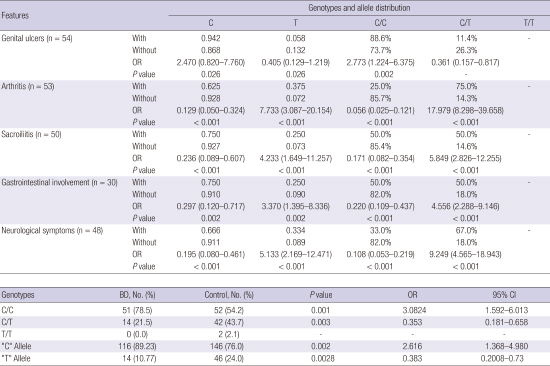1. Sakane T, Takeno M, Suzuki N, Inaba G. Behçet’s disease. N Engl J Med. 1999; 341:1284–1291.
2. Bang DS, Oh SH, Lee KH, Lee ES, Lee SN. Influence of sex on patients with Behçet’s disease in Korea. J Korean Med Sci. 2003; 18:231–235.
3. Aksu K, Donmez A, Keser G. Inflammation-induced thrombosis: mechanisms, disease associations and management. Curr Pharm Des. 2012; 18:1478–1493.
4. La Regina M, Gasparyan AY, Orlandini F, Prisco D. Behçet’s disease as a model of venous thrombosis. Open Cardiovasc Med J. 2010; 4:71–77.
5. Yang SS, Park KM, Park YJ, Kim YW, Do YS, Park HS, Park KB, Kim DI. Peripheral arterial involvement in Behcet’s disease: an analysis of the results from a Korean referral center. Rheumatol Int. 2013; 33:2101–2108.
6. Touitou I, Koné-Paut I. Autoinflammatory diseases. Best Pract Res Clin Rheumatol. 2008; 22:811–829.
7. Lehner T. Immunopathogenesis of Behçet’s disease. Ann Med Interne (Paris). 1999; 150:483–487.
8. Gül A. Behçet’s disease: an update on the pathogenesis. Clin Exp Rheumatol. 2001; 19:S6–12.
9. Direskeneli H. Behçet’s disease: infectious aetiology, new autoantigens, and HLA-B51. Ann Rheum Dis. 2001; 60:996–1002.
10. Verity DH, Wallace GR, Vaughan RW, Stanford MR. Behçet’s disease: from Hippocrates to the third millennium. Br J Ophthalmol. 2003; 87:1175–1183.
11. Oztas MO, Onder M, Gurer MA, Bukan N, Sancak B. Serum interleukin 18 and tumour necrosis factor-alpha levels are increased in Behçet’s disease. Clin Exp Dermatol. 2005; 30:61–63.
12. Sayinalp N, Ozcebe OI, Ozdemir O, Haznedaroğlu IC, Dündar S, Kirazli S. Cytokines in Behçet’s disease. J Rheumatol. 1996; 23:321–322.
13. Higuchi T, Seki N, Kamizono S, Yamada A, Kimura A, Kato H, Itoh K. Polymorphism of the 5′-flanking region of the human tumor necrosis factor (TNF)-alpha gene in Japanese. Tissue Antigens. 1998; 51:605–612.
14. Grove J, Daly AK, Bassendine MF, Day CP. Association of a tumor necrosis factor promoter polymorphism with susceptibility to alcoholic steatohepatitis. Hepatology. 1997; 26:143–146.
15. Rudwaleit M, Tikly M, Khamashta M, Gibson K, Klinke J, Hughes G, Wordsworth P. Interethnic differences in the association of tumor necrosis factor promoter polymorphisms with systemic lupus erythematosus. J Rheumatol. 1996; 23:1725–1728.
16. Fraile A, Nieto A, Beraún Y, Vinasco J, Matarán L, Martín J. Tumor necrosis factor gene polymorphisms in ankylosing spondylitis. Tissue Antigens. 1998; 51:386–390.
17. Kaijzel EL, van Krugten MV, Brinkman BM, Huizinga TW, van der Straaten T, Hazes JM. ö. Functional analysis of a human tumor necrosis factor alpha (TNF-alpha) promoter polymorphism related to joint damage in rheumatoid arthritis. Mol Med. 1998; 4:724–733.
18. Shahram F, Nadji A, Jamshidi AR, Chams H, Chams C, Shafaie N, Akbarian M, Gharibdoost F, Davatchi F. Behçet disease in Iran, analysis of 5,059 cases. Arch Iran Med. 2004; 7:9–14.
19. International Study Group for Behçet’s Disease. Criteria for diagnosis of Behçet’s disease. Lancet. 1990; 335:1078–1080.
20. Miller SA, Dykes DD, Polesky HF. A simple salting out procedure for extracting DNA from human nucleated cells. Nucleic Acids Res. 1988; 16:1215–1220.
21. Bonyadi M, Jahanafrooz Z, Esmaeili M, Kolahi S, Khabazi A, Ebrahimi AA, Hajialilo M, Dastgiri S.
TNF-α gene polymorphisms in Iranian Azeri Turkish patients with Behçet’s disease. Rheumatol Int. 2009; 30:285–289.
22. Verity DH, Marr JE, Ohno S, Wallace GR, Stanford MR. Behçet’s disease, the Silk Road and HLA-B51: historical and geographical perspectives. Tissue Antigens. 1999; 54:213–220.
23. Gül A, Inanç M, Ocal L, Aral O, Koniçe M. Familial aggregation of Behçet’s disease in Turkey. Ann Rheum Dis. 2000; 59:622–625.
24. Verjans GM, Messer G, Weiss EH, van der Linden SM, Kijlstra A. Polymorphism of the tumor necrosis factor region in relation to disease: an overview. Rheum Dis Clin North Am. 1992; 18:177–186.
25. Ateş A, Kinikli G, Düzgün N, Duman M. Lack of association of tumor necrosis factor-alpha gene polymorphisms with disease susceptibility and severity in Behçet’s disease. Rheumatol Int. 2006; 26:348–353.
26. Storz K, Löffler J, Koch S, Vonthein R, Zouboulis CC, Fresko I, Yazici H, Kötter I. IL-6 receptor, IL-8 receptor and TNF-alpha238 (G/A) polymorphisms are not associated with Behçet’s disease in patients of German or Turkish origin. Clin Exp Rheumatol. 2008; 26:S103–6.
27. Park K, Kim N, Nam J, Bang D, Lee ES. Association of TNFA promoter region haplotype in Behçet’s disease. J Korean Med Sci. 2006; 21:596–601.
28. Ahmad T, Wallace GR, James T, Neville M, Bunce M, Mulcahy-Hawes K, Armuzzi A, Crawshaw J, Fortune F, Walton R, et al. Mapping the HLA association in Behçet’s disease: a role for tumor necrosis factor polymorphisms? Arthritis Rheum. 2003; 48:807–813.
29. Touma Z, Farra C, Hamdan A, Shamseddeen W, Uthman I, Hourani H, Arayssi T. TNF polymorphisms in patients with Behçet disease: a meta-analysis. Arch Med Res. 2010; 41:142–146.
30. Amirzargar A, Shahram F, Nikoopour E, Rezaei N, Saeedfar K, Ziaei N, Davatchi F. Proinflammatory cytokine gene polymorphisms in Behçet’s disease. Eur Cytokine Netw. 2010; 21:292–296.








 PDF
PDF ePub
ePub Citation
Citation Print
Print




 XML Download
XML Download